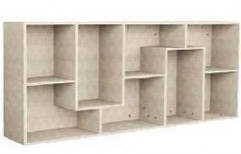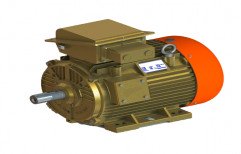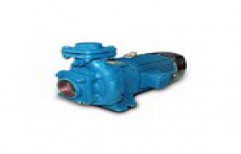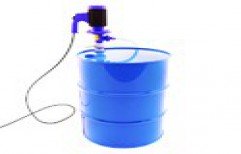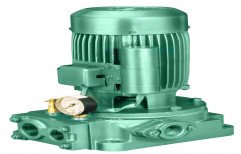Featured Suppliers
How it works
- Submit an enquiry to a product.
- Wait for a call from nearest supplier from your area.
- Get quote and product details.
- Choose best from them.
Recently Added Suppliers
Product Description
Mixed-bed deionizers are normally used to ‘polish' the water to higher levels of purity after it has been initially treated by either a two-bed deionizer or a reverse osmosis unit.In mixed-bed deionizers the Strong Acid Cation and Strong Base Anion resins are closely mixed and contained in a single pressure vessel. The thorough mixture of resins in a single column makes a mixed-bed deionizer equivalent to anextended series of two-bed plants. As a result, the water quality obtained from a mixed-bed deionizer is appreciably higher than that produced by a two-bed plant.
We at Shubham, providesbroad range of custom-built Mixed Bed Units for high purity industrial process water & utility applications.Our exclusive design of Mixed Bed plant ensures the maximum utilization of the High bed depth, effective surface area, uniform space and linear velocity across the resin bed,which provides effective contact time between water and resin bed yield high purity water for sensitive process application i.e. WFI (water for Injection) High Pressure Boilers, EC circuits etc.
Shubham MB Plants are available in diameters from 0.225 Mts. to 2.0 Mts. with the flow ratesup to 150M3/Hr. and OBR up to 1500 M3@40 PPM TDS. These strong, pre-engineered, pre-assembled units minimizei nstallation and start-up costs. Our D.M. Plant is acclaimed in the market for cost efficiency and consistent functioning.
Operating Principle:
A mixed bed exchanger has both cation and anion resin mixed together in a single vessel. As water flows through the resin bed, the ion exchange process is repeated many times, "polishing" the water to a very high purity. During regeneration, the resin is separated into distinct cation and anion fractions. The resin is separated by backwashing, with the lighter anion resin settling on top of the cation resin. Regenerant acid is introduced through the bottom distributor, and caustic is introduced through distributors above the resin bed. The regenerant streams meet at the boundary between the cation and anion resin and discharge through a collector located at the resin interface. Following regenerant introduction and displacement rinse, air and water are used to mix the resins. Then the resins are rinsed, and the unit is ready for service.
Counterflow and mixed bed systems produce a purer water than conventional cation-anion demineralizers, but require more sophisticated equipment and have a higher initial cost. The more complicated regeneration sequences require closer operator attention than standard systems. This is especially true for a mixed bed unit
Salient Features:
Benefits
We at Shubham, providesbroad range of custom-built Mixed Bed Units for high purity industrial process water & utility applications.Our exclusive design of Mixed Bed plant ensures the maximum utilization of the High bed depth, effective surface area, uniform space and linear velocity across the resin bed,which provides effective contact time between water and resin bed yield high purity water for sensitive process application i.e. WFI (water for Injection) High Pressure Boilers, EC circuits etc.
Shubham MB Plants are available in diameters from 0.225 Mts. to 2.0 Mts. with the flow ratesup to 150M3/Hr. and OBR up to 1500 M3@40 PPM TDS. These strong, pre-engineered, pre-assembled units minimizei nstallation and start-up costs. Our D.M. Plant is acclaimed in the market for cost efficiency and consistent functioning.
Operating Principle:
A mixed bed exchanger has both cation and anion resin mixed together in a single vessel. As water flows through the resin bed, the ion exchange process is repeated many times, "polishing" the water to a very high purity. During regeneration, the resin is separated into distinct cation and anion fractions. The resin is separated by backwashing, with the lighter anion resin settling on top of the cation resin. Regenerant acid is introduced through the bottom distributor, and caustic is introduced through distributors above the resin bed. The regenerant streams meet at the boundary between the cation and anion resin and discharge through a collector located at the resin interface. Following regenerant introduction and displacement rinse, air and water are used to mix the resins. Then the resins are rinsed, and the unit is ready for service.
Counterflow and mixed bed systems produce a purer water than conventional cation-anion demineralizers, but require more sophisticated equipment and have a higher initial cost. The more complicated regeneration sequences require closer operator attention than standard systems. This is especially true for a mixed bed unit
Salient Features:
- MOC - FRP / MSRL / MSEP
- Ion exchange Vessels
- Cation Resin of reputed make
- Automatic / Semiautomatic
- 12auto valves & High quality CPVC piping
- PLC based control panel
Benefits
- Rinse water requirements are very low
- Water purity very high
- Low Maintenance
- Leak proof
- High Pressure Boiler Feed
- Water for Injection (WFI)
- EC circuits
- Laboratories & R&D Centers



